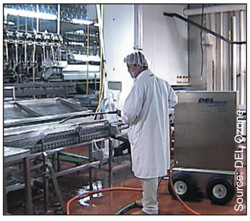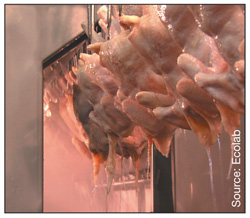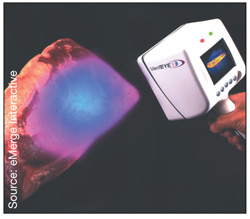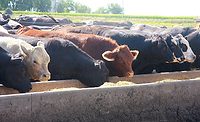Forgive the pun, but there are some killer microbial intervention technologies on the market that are of keen interest to the food industry. The number of commercially available thermal, non-thermal, antimicrobial chemical and other novel treatments applied to foods and/or food-contact surfaces designed to inhibit, reduce or inactivate microorganisms has never been greater—or more in demand by food manufacturing operations.
What has driven a surge in the development and availability of new and improved interventions? Certainly, part of the answer is that regulatory, industry and research institutions have formed a strong partnership supporting the use of quantitative microbial risk assessments to identify critical points within the food chain at which effective interventions will have the greatest impact on reducing foodborne illness. Several of the U.S. Food and Drug Administration’s (FDA) and the U.S. Department of Agriculture’s (USDA) more recent industry guidelines, directives and proposed rules reflect this unified push to apply intervention technologies to improve food safety. FDA’s 2004 Produce Safety Action Plan, for example, identifies as part of the agency’s objectives the promotion of risk assessments to identify with industry the microbial interventions that will be most effective in produce operations.
Similarly, USDA’s Food Safety and Inspection Service (FSIS) interim final rule on the control of Listeria monocytogenes in ready-to-eat (RTE) meat and poultry products (Directive 10,240.4) provides incentives for RTE producers to use post-lethality treatments, antimicrobials ingredients at formulation and other intervention technologies to significantly reduce the risk of the presence or growth of Listeria on these products. And, industry has been vocal in expressing its desire that new intervention strategies receive expedited regulatory agency review, as companies search for viable options that will improve their ability to prevent, control and eliminate undesirable microorganisms through HACCP, GMP and other food safety programs.
As Food Safety Magazine’s editors have traveled the country this year, we’ve been introduced to several innovative, new or improved technologies and systems designed for use as part of the multi-hurdle intervention approachto food safety. Here, we’ll highlight some of these in-plant thermal, non-thermal, chemical and novel microbial intervention systems as a quick guide to the latest advances in this important area of food safety.
Hot Thermal Interventions
Applying heat to foods and food-contact surfaces, either as a validated kill step or as a pathogen reduction method, is the classic means by which to achieve processing, packaging and post-packaging intervention. From steam treatments to dry heat to cook steps, the higher the temperatures applied, the higher the confidence that bacteria have been destroyed. For some foods, however, heat treatments can have an adverse affect on the quality attributes of finished product, such as minimally processed fruits and vegetables. Some of the newer microbial intervention technologies are designed with this issue in mind and thus are capturing the attention of food manufacturers nationwide.
One such thermal technology, Biosteam Technologies, Inc.’s trademarked ThermoSafe system, is a pasteurization method that has proven effective in the area of surface decontamination of fruits and vegetables destined for further processing, including fresh juice, cut fruit and melons, fruit concentrates and smoothies. The company reports that research conducted by Food Safety Net Services, Ltd., an ISO/IEC 17025 accredited network of laboratories, shows that the ThermoSafe process can be effective in reducing the microbial load of Listeria monocytogenes, Salmonella spp., E. coli O157:H7, and Lactobacillus spp. on the surface of fruits and vegetables by 5 logs, and in some cases, up to 9 logs. In addition to the safety factor of the process, studies indicate taste panels were able to determine a sweeter flavor from the steamed fruit over the control or unsteamed product.
In describing the process, Biosteam notes that the ThermoSafe process uses time and temperature settings, depending on the commodity, to facilitate the desired microbial intervention step. The system can serve to clean and sanitize both products and equipment in minutes, automatically ending the sanitizing cycle at a predetermined temperature. This technology is designed to provide the user with a constant supply of steam, whether in the form of a portable unit or a large scale in-line applications system.
 Similarly, ALKAR-RapidPak’s Surface Pasteurization Technology (RP-SP) is designed to produce safer food products without loss of desirable product sensory characteristics. This flash pasteurization system promises a 3-log reduction for Listeria monocytogenes, for example, with no formula change required and no effect on packaging films. While a conventional pasteurization method essentially recooks product, taking between four to 20 minutes of application time that must be followed by re-chilling, the RP-SP is designed to achieve surface pasteurization in 1.5 seconds. The system module uses bursts of steam and a jostling mechanism to pasteurize all surfaces of food products, followed by the injection of rapid bursts of high-pressure steam.
Similarly, ALKAR-RapidPak’s Surface Pasteurization Technology (RP-SP) is designed to produce safer food products without loss of desirable product sensory characteristics. This flash pasteurization system promises a 3-log reduction for Listeria monocytogenes, for example, with no formula change required and no effect on packaging films. While a conventional pasteurization method essentially recooks product, taking between four to 20 minutes of application time that must be followed by re-chilling, the RP-SP is designed to achieve surface pasteurization in 1.5 seconds. The system module uses bursts of steam and a jostling mechanism to pasteurize all surfaces of food products, followed by the injection of rapid bursts of high-pressure steam.
"Cool" Interventions Emerge
Once considered “novel” technologies relegated to pilot plant research, non-thermal intervention systems are beginning to take their place in the real world of the food plant. A few of these technologies have been available to industry for awhile, but have recently experienced a resurgence of interest as application ranges have broadened and procedures for use are better understood by end-users. For example, since obtaining FDA GRAS status for use as a direct food contact antimicrobial agent in 2001, ozone is gaining many industry adherents as an additional intervention to strengthen food safety programs, such as HACCP and GMPs, in the processing plant and beyond. Ozone, which is an effective biocide against biofilms, bacteria, viruses, fungi and protozoa, has long been successfully used for no-rinse sanitation of food-contact surfaces and in clean-in-place (CIP) systems in food plants. Today, ozone also can be dissolved into water and used for direct contact on fruits and vegetables, raw and ready-to-eat meat and poultry, fish and commercial eggs, making this an intervention that can be used along the entire food production chain.
 According to DEL Ozone, which manufactures the AGW Series of ozone-enriched water systems for sanitation and direct food contact applications, the primary benefit of ozone-enriched water is that it kills microbes as effectively as chlorine, sans residual chemicals. For example, DEL’s ozone-enriched water efficacy testing, performed by the National Sanitation Foundation (NSF) under AOAC International methodology, shows that ozone dissolved in water can provide a 6-log reduction of Staphyloccoccus aureus, Salmonella choleraesuis and Pseudomonas aeruginosa in as little as 30 seconds (depending on the microorganism). The testing also shows that a 5-log reduction of E. coli, and a 4-log reduction of both Listeria monocytogenes and Campylobacter jejuni can be obtained.
According to DEL Ozone, which manufactures the AGW Series of ozone-enriched water systems for sanitation and direct food contact applications, the primary benefit of ozone-enriched water is that it kills microbes as effectively as chlorine, sans residual chemicals. For example, DEL’s ozone-enriched water efficacy testing, performed by the National Sanitation Foundation (NSF) under AOAC International methodology, shows that ozone dissolved in water can provide a 6-log reduction of Staphyloccoccus aureus, Salmonella choleraesuis and Pseudomonas aeruginosa in as little as 30 seconds (depending on the microorganism). The testing also shows that a 5-log reduction of E. coli, and a 4-log reduction of both Listeria monocytogenes and Campylobacter jejuni can be obtained.
DEL Ozone systems enable operators to apply ozone in both aqueous and gaseous forms to fruits, vegetables, meat, poultry and fish products, and can be easily integrated into flume, cascade, or drench type operations, as well as into both ozone prewash and ozone wash sections.
Ozone’s effectiveness as an intervention goes beyond pathogens. In studies conducted by Silliker, Inc., Novazone patented ozone-based purification technologies have been shown to be effective in disinfecting, inhibiting or removing mold growth, reducing contamination and decay, and improving shelf life. In one study, Novazone applied gaseous ozone for one night in a 175,000-cubic-ft. cold storage room containing contaminated lemons with a measurable aerobic plate count of more than 3 million colony forming units (CFUs) of microorganisms per gram. The independent testing showed that the ozone treatment not only reduced contaminants by a 2-3 log count, but in the bin dump room, also reduced the yeast count from 900,000 CFUs (untreated) to 32,000 CFUs (treated) and the mold count from 400,000 CFUs (untreated) to 70,000 CFUs (treated).
Again, non-thermal intervention technologies promise the food industry effective pathogen reduction as well as enhanced product quality and shelf life. Ozone technology is no exception, according to The BOC Group, whose ozone-based pathogen control technology from its food safety technology and consulting division, Intervent, is receiving good response from clients such as the Norway-based Stolt Sea Farm, a $1 billion global aquaculture company that has installed the technology in its Los Angeles, CA and Stratford, CT plants. The plants, which process sturgeon and salmon, have made the Intervent system a core component of their pathogen reduction strategies, and report that validation tests have confirmed that, in addition to reducing pathogens, ozone had a significant, positive impact on product quality and shelf life. As a result, Stolt plans to eventually introduce the technology in all of its processing plants.
Continued research also has informed system design improvements to ensure the delivery of the correct amount of ozone reliably and safely to food products and food-contact surfaces to increase the intervention benefit. Many ozone technology developers, for example, now have in-depth material compatibility sheets to increase the ensure the good condition of equipment and components after treatment. While aqueous ozone is compatible with many materials, including ceramic, glass, silicone and Teflon seals, and stainless steel piping, in the recent past, some end-users were unaware that aqueous ozone should not be applied on surfaces made with natural rubbers, polyurethane or resin-based plastics.
In an effort to provide informative materials on the technology’s proper application, a new player in the market, Ozone Safe Food/eFoodSafety.com, has launched an in-depth website to help industry enhance its understanding of this intervention. The company offers several equipment models that feature its patented Vortex Mixing System, which compresses the ozone into microscopic bubbles in the water solution. The result, says the company, is higher ozone residuals with less off-gas to achieve a faster, more effective application.
High pressure processing (HPP), an automated system that kills microorganisms by interrupting their cellular function without the use of heat, is another intervention that is becoming more widely available—and affordable—for food processors. HPP emerged in the 1990s as a food pasteurization alternative to heat or irradiation processing but initial costs of the systems have prevented their widespread use. Studies show that the process also extends product shelf life by inactivating spoilage organisms, and when appropriately used, does not alter the texture, appearance or flavor of foods. HPP is effective on food products such as RTE meat, cheese, guacamole, fruit juice, onions, salsa, oysters and other seafood.
In addition, in preliminary studies reported in March 2005, FDA/USDA research collaborators found that one-minute HPP treatments of oysters significantly reduced hepatitis A virus from study samples. Researchers also indicated that the technology might be successfully used as an intervention against noroviruses in the future.
As the first commercial tolling processor, American Pasteurization Co. (APC) has introduced what it describes as access to food processors with volumes too low to justify the investment in HPP equipment. The company works with processors to incorporate HPP into their current distribution chain, so that food is not only treated at APC, but can be date-stamped, labeled, packaged and boxed on its way to distributors and retailers. APC aims to make HPP easier and more convenient by eliminating extra shipping steps for small- to mid-sized processing operations that are interested in supplementing their existing manufacturing practices and processes with an additional food safety intervention step.
Avure Technologies Inc. recently introduced its next-generation 215L ULTRA HPP system for higher-volume plant operations, particularly for sliced RTE meat processors looking for a post-packaging lethality step that inactivates Listeria monocytogenes in accordance with the recent USDA FSIS directive. This latest design upgrades Avure’s 215-liter pressure vessel with a dual-pump pressurization system that uses a new generation of pressure intensifiers to accelerate process steps. Along with an advanced PC-based control system that allows multiple units to be monitored and controlled from a central location, Avure also has shortened the system’s cycle times to improve throughput.
Beginning in 1990, FDA approved irradiation (ionizing radiation) treatments as a safe and effective microbial reduction method for categories including spices, poultry and eggs, red meats, ground beef, seafood, sprouts, and fruits and vegetables. Currently, FDA is considering adding RTE meats, including hot dogs, deli ham and turkey and bologna, to the list of foods that can be treated with ionizing radiation. Earlier this year, USDA researchers with the Agricultural Research Service (ARS) Food Safety Intervention Technologies Research Unit reported that there may be other benefits to using this non-thermal method, which inactivates pathogens, parasites and spoilage organisms by destroying or damaging their cell membranes.
In studies on the use of irradiation to eliminate Listeria monocytogenes from RTE meats, the USDA researchers found that certain common food additives, such as a combination of acetic acid salts and lactic acid in bologna formulations, make Listeria more sensitive to radiation, thus allowing a significant reduction the dose of radiation needed to inactivate the pathogen to maintain product quality attributes. The researchers noted that the combined treatments also prevented growth of spoilage microorganisms for two months in some RTE meats. “Ionizing radiation, when combined with common food additives, has the potential to significantly reduce the incidence of listeriosis associated with consumption of RTE meats in the U.S.,” concluded the scientists.
Commercially available irradiation technologies, such as gamma processing technology pioneer MDS Nordion’s Centurion and Sterigenics’ electron beam, gamma and X-ray processing technologies are well established as effective microbial interventions, from receiving through processing to post-packaging applications. Given the findings of this new research, the food industry will likely see some enhancements of irradiation technologies and systems to incorporate additional things like food additives.
Chemical Interventions on the Rise
One of the most active areas of new technology development is chemical intervention systems, in the form of both direct food additives and secondary additives, or food contact-surface treatments. (See FSM, Dec./Jan. 2005, Advances in Antimicrobial Ingredients, by Crozier-Dodson, et al, p. 24, for a detailed look at direct food additives.)
Several antimicrobial chemical treatments have been recently recognized by USDA in its New Technology Information Table (www.fsis.usda.gov/regulations_&_policies/New_Technology_Table/index.asp) as suitable interventions for use in meat and poultry operations. Mionix’s Safe2O brand line of products makes the list, with both USDA approved, multi-platform pasteurization technologies and proprietary antimicrobial agent formulations. The Safe2O RTE 03 chemical intervention, for example, involves a unique blend of acidic calcium sulfate, lactic acid and propionic acid that kills bacteria on contact and prevents further growth of Listeria monocytogenes on various ham products and other RTE food products. The product is a validated one-step solution to achieve Alternative 1 in FSIS Directive 10,240.4.
Surface-friendly chemical solutions, such as peracetic or peroxyacetic acids, also are gaining popularity. These microbial interventions are compatible with a range of surface materials, providing antimicrobial efficacy as well as protection from corrosion or other chemical-caused damage to equipment. For example, AFCO’s PeraSafe, composed of 15% peracetic acid and 10% H2O2, combines the proven efficacy of an oxidizer with an organic acid, reducing corrosion rates on machinery. PeraSafe is used as a direct microbial intervention on meat and poultry carcasses and in fabrication applications, including ground beef, cuts and trims.
 Ecolab’s EcoShield, its integrated interventions systems program that offers the food industry a holistic, multiple-intervention approach, combines antimicrobial chemical treatments, irradiation technology and sanitation control systems to reduce or eliminate pathogens. Among its chemical antimicrobials, Ecolab’s Inspexx 100 and 200 peroxyacetic acid-based food surface treatments are recommended for use in poultry spray rinsing and chill water to reduce microbial contamination on processed poultry surfaces, and for use in carcass sprays to control microbes on red meat surfaces, respectively. When used with certain dispensing equipment, notes the company, system performance is optimized and greater antimicrobial efficacy against Salmonella typhimurium, Campylobacter jejuni, Listeria monocytogenes and E. coli O157:H7 is achieved.
Ecolab’s EcoShield, its integrated interventions systems program that offers the food industry a holistic, multiple-intervention approach, combines antimicrobial chemical treatments, irradiation technology and sanitation control systems to reduce or eliminate pathogens. Among its chemical antimicrobials, Ecolab’s Inspexx 100 and 200 peroxyacetic acid-based food surface treatments are recommended for use in poultry spray rinsing and chill water to reduce microbial contamination on processed poultry surfaces, and for use in carcass sprays to control microbes on red meat surfaces, respectively. When used with certain dispensing equipment, notes the company, system performance is optimized and greater antimicrobial efficacy against Salmonella typhimurium, Campylobacter jejuni, Listeria monocytogenes and E. coli O157:H7 is achieved.
Ecolab also offers Tsunami, a peroxyacetic acid-based additive used for microbial control in fresh-cut, processed and post-harvest fruit and vegetable flume and wash water systems.
PURAC America’s Purasal Opti.Form, a blend of sodium or potassium lactate and sodium diacetate, also is well-suited for the multi-hurdle intervention approach. Research by Oscar Mayer’s R&D team has shown that the antimicrobial can effectively suppress the growth of Listeria monocytogenes in RTE meats.
More Interventions of Interest
 Other novel or improved technologies and applications of interest to food processors provide the opportunity for intervention and reduction of overall bioburden as a way to further enhance food safety. For example, e-Merge Interactive’s fluorescence-based real-time imaging technology, VerifEYE, which is a used by meat processors in the U.S. to instantly detect and verify trace amounts of organic contamination on meat surfaces that can harbor pathogens such as E. coli O157:H7 and Salmonella, provides a detailed display of surface contamination of incoming meat products, which can then be accurately and rapidly removed—before carcasses travel further into the processing plant. The technology, which is available in a portable handheld version called the Solo, designed for spot-checking surfaces, as well as in an automated, in-line Carcass Inspection System (CIS), for automated inspection of entire carcasses, has been recognized as an effective tool for reducing contamination prior to the application of other microbial interventions during further processing.
Other novel or improved technologies and applications of interest to food processors provide the opportunity for intervention and reduction of overall bioburden as a way to further enhance food safety. For example, e-Merge Interactive’s fluorescence-based real-time imaging technology, VerifEYE, which is a used by meat processors in the U.S. to instantly detect and verify trace amounts of organic contamination on meat surfaces that can harbor pathogens such as E. coli O157:H7 and Salmonella, provides a detailed display of surface contamination of incoming meat products, which can then be accurately and rapidly removed—before carcasses travel further into the processing plant. The technology, which is available in a portable handheld version called the Solo, designed for spot-checking surfaces, as well as in an automated, in-line Carcass Inspection System (CIS), for automated inspection of entire carcasses, has been recognized as an effective tool for reducing contamination prior to the application of other microbial interventions during further processing.
Engelhard Corp. is building the antimicrobial agent directly into packaging film in an innovative intervention application. The company’s Aseptrol antimicrobial, a chlorine dioxide formulation that rapidly kills bacteria, viruses and cysts, is being incorporated into antimicrobial films that will enhance long-term or residual control of microbial contamination, as well as potentially extend shelf life. According to Engelhard, applications for these antimicrobial films range from packaging meat, poultry and seafood, to fresh fruits, vegetables and foods in transit or storage from producers to processors or institutional users.
 Similarly, Next Conveyor (formerly Materials Systems Engineering) has built a preventive barrier to bacterial bioburden directly into its NEXGEN conveyors. The company incorporates antimicrobial belting and bacteria-killing components as part of its sanitary design of NEXGEN conveyors. By using Westlake Plastics Technologies’ Silveron product, the patented silver-based antimicrobial technology belonging to Milliken Chemical, the next-generation conveyors are kept cleaner by preventing or reducing the formation of biofilm on the equipment surface. The silver ions provide the product with its broad antimicrobial characteristics and are contained in tiny ceramic crystals that release the silver as needed. The controlled release and dispersion of the additive throughout the components ensures long-term antimicrobial intervention.
Similarly, Next Conveyor (formerly Materials Systems Engineering) has built a preventive barrier to bacterial bioburden directly into its NEXGEN conveyors. The company incorporates antimicrobial belting and bacteria-killing components as part of its sanitary design of NEXGEN conveyors. By using Westlake Plastics Technologies’ Silveron product, the patented silver-based antimicrobial technology belonging to Milliken Chemical, the next-generation conveyors are kept cleaner by preventing or reducing the formation of biofilm on the equipment surface. The silver ions provide the product with its broad antimicrobial characteristics and are contained in tiny ceramic crystals that release the silver as needed. The controlled release and dispersion of the additive throughout the components ensures long-term antimicrobial intervention.
AgION Technologies’ AgION antimicrobial coating technology another silver ion delivery system being used in the manufacture of building and equipment components to inhibit microbial growth. Interesting applications include the use of AgION in hardware and plumbing used in the foodservice industry, and in commercial HVAC air handling units.
Read the sidebar "KSU Process Protects Ready-to-Eat Beef from Pathogens."
Julie Larson Bricher is Editorial Director of Food Safety Magazine.
KSU Process Protects Ready-to-Eat Beef from Pathogens
The good news for consumers is that there are more ready-to-eat (RTE) meat products on the market and that vacuum packaging has made it possible to keep them fresh in appearance and taste. The problem is that pathogenic bacteria can grow on the meat in this packaging at both room and refrigeration temperatures.
The better news is that Food Safety Consortium researchers at Kansas State University have found that a solution of sodium citrate can inhibit the growth of the bacterium Clostridium perfringens on restructured roast beef.
RTE meats go through a mild heat treatment, but the treatment stimulates rather than reduces the growth of the bacterium in vacuum packaging. One way to prevent the problem would be to follow federal guidelines to sharply cool down the meat within five hours. But not all of the current refrigeration technology makes that possible.
So, according to KSU food science professor Dr. Daniel Y.C. Fung, “There is a need for additional secondary safety barriers in vacuum-packaged meat products that will help prevent the growth of anaerobic bacteria such as C. perfringens during cooling procedures.”
C. perfringens is a common foodborne bacterium that the federal government reported was responsible for more than 6% of bacterial foodborne disease outbreaks in 2000. Its significance lies also in its designation by the Centers for Disease Control and Prevention as an organism that can produce toxin that could potentially be used in a bioterrorist attack.
Fung’s experiments showed that all sodium citrate treatments reduced C. perfringens after the cooking step and before the end of the 18-hour cooling step and suppressed its further growth.
The process would be particularly beneficial to smaller meat processors that may not have the equipment to cool down their meat far enough fast enough. Fung said sodium citrate would create another hurdle to block the growth of C. perfringens. “It’s another safety measure in case something goes wrong,” Fung said. “The antimicrobials would help control the food to make it safer.”
With ground beef, results were similar after heating followed by cooling. “The combination of heat and sodium citrate proved to be an effective preventive method against C. perfringens growth by damaging the bacterium’s cell structure,” Fung said.
Fung said his research team continues to examine the issue by using electron microscope transmissions to study the mechanism of killing the pathogen. “We want to see whether the organisms disintegrate or whether the cell structure changes,” he said, noting that industry could likely use such data.




